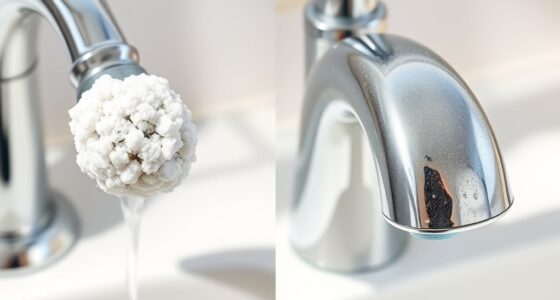Switching to green cleaning methods can markedly improve your indoor air quality by cutting down on harmful chemicals and VOCs that pollute your space. Using natural products like vinegar and baking soda reduces chemical exposure and helps keep the air fresher and healthier. Combining these practices with air purifiers and good ventilation can further enhance your environment. If you want to discover more ways to create a safer indoor space, keep exploring these effective strategies.
Key Takeaways
- Green cleaning reduces indoor chemical emissions, lowering VOC levels and improving air quality.
- Natural cleaning agents like vinegar and baking soda emit fewer pollutants than synthetic chemicals.
- Using air purifiers alongside green cleaning enhances removal of airborne allergens and VOCs.
- Proper ventilation combined with eco-friendly products minimizes indoor pollutant buildup.
- Integrated practices create a healthier indoor environment by decreasing chemical exposure and improving air freshness.

Many traditional cleaning products release harmful chemicals into the air, which can negatively affect indoor air quality. These chemicals, including volatile organic compounds (VOCs), can cause respiratory issues, allergic reactions, and long-term health problems. Switching to green cleaning methods can make a significant difference in creating a healthier indoor environment. One of the key benefits of using an air purifier is its ability to improve air quality by removing airborne pollutants, including VOCs. Air purifier benefits are especially noticeable when combined with VOC reduction strategies, such as choosing natural cleaning products and ensuring proper ventilation. When you opt for green cleaning supplies, like vinegar, baking soda, or eco-friendly commercial products, you reduce the introduction of VOCs into your space. These strategies not only lower chemical exposure but also contribute to cleaner, fresher air. Implementing air purification technology enhances the effectiveness of these practices by continuously filtering out pollutants from the air. Using an air purifier with a HEPA filter can trap tiny particles and allergens that traditional cleaning might leave behind. This is particularly important in spaces where you or your family members have asthma or allergies. The benefits extend beyond just removing particles; some air purifiers are equipped with activated carbon filters that specifically target VOCs and odors. This dual-action enhances the overall indoor air quality, making your environment safer and more comfortable. Implementing VOC reduction strategies involves more than just selecting green cleaning products; it also means maintaining good ventilation, opening windows when possible, and avoiding the use of harsh, synthetic air fresheners. These practices work in tandem with air purifiers to reduce airborne chemical concentrations.
Frequently Asked Questions
How Does Green Cleaning Compare Cost-Wise to Traditional Cleaning?
Green cleaning is often comparable in cost to traditional cleaning, but your cost comparison depends on factors like the products you choose and your budget considerations. While some green cleaning supplies may have a higher upfront price, you can save money over time by reducing health risks and cleaning frequency. Overall, you might find green cleaning fits your budget better, especially if you prioritize healthier indoor environments and long-term savings.
Are All Green Cleaning Products Equally Effective at Cleaning?
Some green cleaning products are as effective as traditional ones, but not all. You might find that ingredient variability affects their chemical effectiveness, meaning some work wonders while others fall short. Think of it like a toolbox—some tools are reliable, others less so. Always check labels and reviews to make sure you’re choosing products that meet your cleaning needs without compromising safety or performance. Don’t settle for less than the best.
Can Green Cleaning Eliminate All Indoor Air Pollutants?
Green cleaning can’t eliminate all indoor air pollutants, but it markedly reduces volatile compounds and allergens. By avoiding harsh chemicals, you lower the presence of harmful fumes and irritants in your indoor environment. Regular green cleaning helps improve air quality by minimizing allergen buildup and reducing toxic emissions. While it may not remove every pollutant, adopting eco-friendly products creates a healthier space for you and your family.
How Long Does It Take to See Improvements in Air Quality?
You can typically see improvements in air quality within a few days to a week after switching to green cleaning practices. The air quality timeline varies depending on factors like the extent of pollution and ventilation. Generally, you’ll notice a positive change in air freshness and reduced odors in about 3 to 7 days. Consistent green cleaning can speed up the improvement duration, creating a healthier indoor environment sooner.
Are There Any Indoor Plants That Can Replace Green Cleaning?
While indoor plants offer many benefits, they can’t fully replace green cleaning for improving air quality. Plants like spider plants, snake plants, and peace lilies act as natural air purifiers, removing toxins and increasing humidity, but they can’t eliminate all pollutants or bacteria. Incorporating these natural air purifiers alongside regular cleaning creates a healthier indoor environment, combining the benefits of both green cleaning and indoor plant benefits for ideal air quality.
Conclusion
By choosing green cleaning, you’re opening a window to fresher air—like a gentle breeze sweeping away stubborn pollutants. Your efforts turn your space into a lush, breathing garden where clean air flows freely, nurturing health and comfort. Each eco-friendly product acts as a sunbeam, illuminating your home’s natural purity. Embrace these mindful choices, and watch your indoor air transform into a pristine sanctuary—an oasis where freshness blooms with every breath you take.









